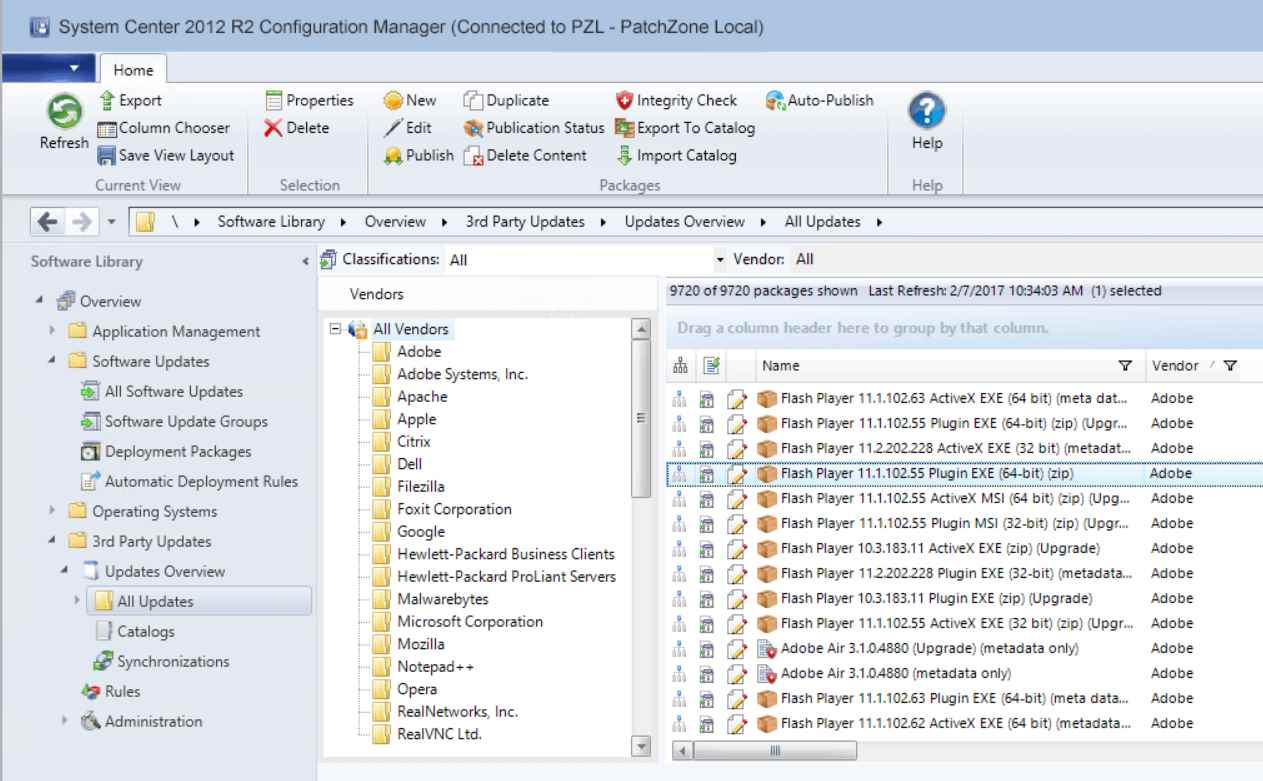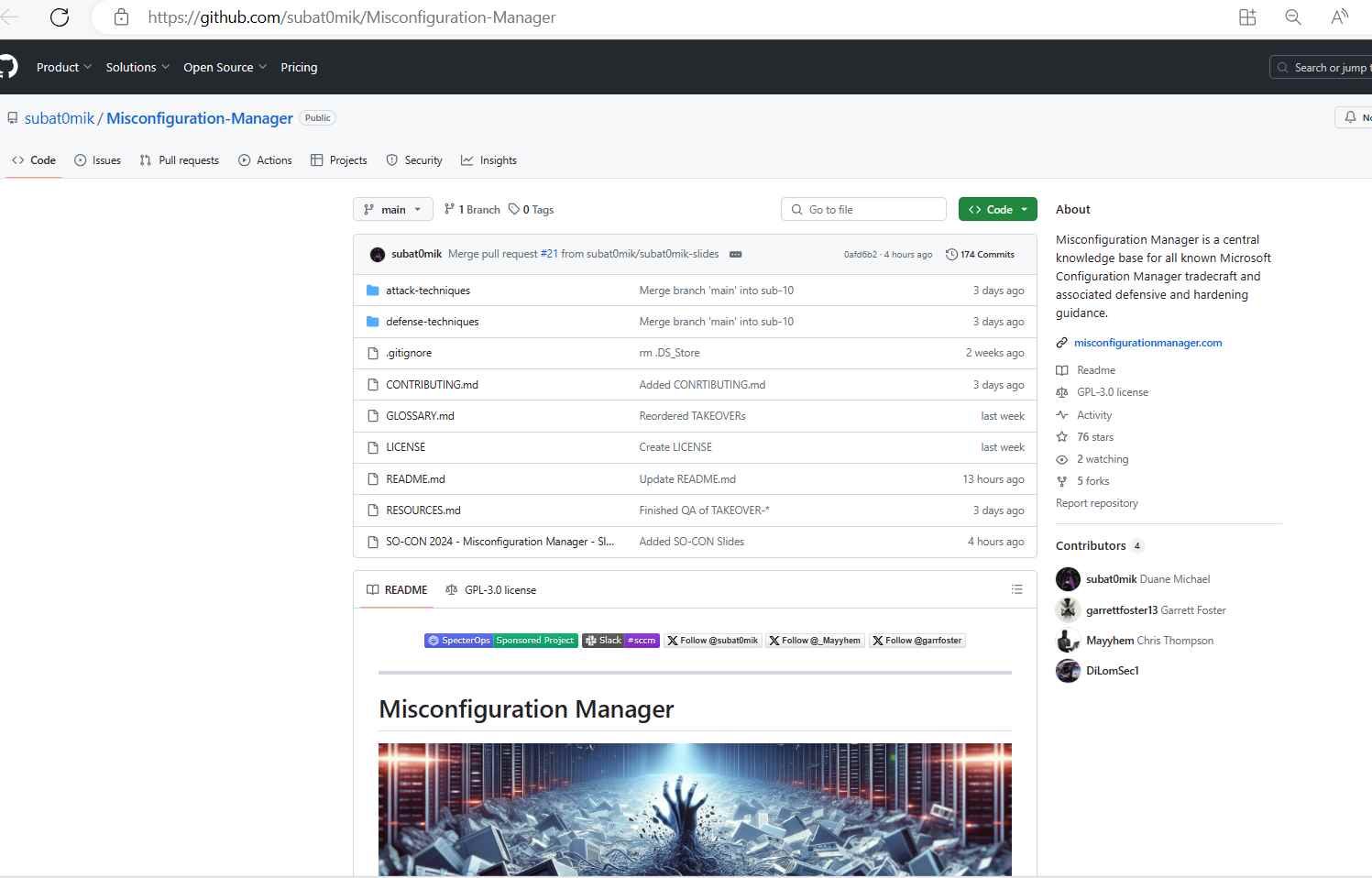At the recent SO-CON security conference, researchers have brought to light significant misconfigurations in Microsoft’s System Center Configuration Manager (SCCM), now known as Configuration Manager. These misconfigurations, if exploited, could lead to severe security vulnerabilities, allowing cyber attackers to infiltrate and compromise systems.
A team of security researchers has meticulously created a knowledge base repository focusing on attack and defense techniques stemming from improper setups of Microsoft’s Configuration Manager. This repository serves as a crucial resource for cybersecurity professionals, offering insights into potential vulnerabilities and how to safeguard against them.

The findings presented at SO-CON highlight the critical nature of proper system configuration and the potential risks associated with oversight. Microsoft SCCM, a widely used tool for managing large groups of computers running Windows, is integral to the IT infrastructure of numerous organizations. Misconfigurations in such a pivotal system can lead to unauthorized access, data breaches, and a host of other security issues.
In the evolving landscape of cybersecurity, the Microsoft Configuration Manager (SCCM) has emerged as both a cornerstone for operational efficiency and a potential vector for sophisticated cyber attacks. Recent research, culminating in a presentation at SO-CON 2024, has shed light on the intricate web of misconfigurations that plague SCCM, revealing vulnerabilities that could be exploited by adversaries.
Background: A Legacy of Complexity
Originally released in 1994, Configuration Manager has become a ubiquitous tool in Windows and Active Directory environments, managing applications, software updates, operating systems, and compliance settings across extensive networks. However, its longevity brings a legacy of technical debt and compounding misconfigurations, making it a ripe target for attackers. The tool’s complexity and critical role in IT infrastructure mean that even minor misconfigurations can have significant security implications.
The Turning Point in SCCM Security Research
The journey into SCCM’s vulnerabilities gained momentum around 2021 when researchers Chris Thompson and Duane embarked on a red team operation. Their objective led them to exploit SCCM’s user device affinity feature to locate a specific user’s workstation, a task that culminated in the development of SharpSCCM, a C# port of the PowerSCCM tool. This initiative sparked a resurgence in SCCM research, with contributions from numerous security professionals, including the development of new tools and the publication of insightful blog posts.
Introducing Misconfiguration Manager
To address the overwhelming complexity and scattered nature of SCCM security information, the researchers introduced “Misconfiguration Manager.” This central knowledge base compiles all known SCCM tradecraft, defensive strategies, and hardening guidance. It aims to simplify attack path management for defenders and educate offensive professionals on SCCM’s vulnerabilities. Inspired by the MITRE ATT&CK framework, Misconfiguration Manager is a living repository that encourages community contributions, ensuring its relevance and utility in the face of evolving threats.
Misconfiguration Manager is a groundbreaking initiative by SpecterOps aimed at demystifying the complexities surrounding Microsoft Configuration Manager (SCCM) misconfigurations. This central knowledge base is designed to consolidate all known SCCM tradecraft, along with associated defensive and hardening guidance. It serves as a beacon for both offensive and defensive cybersecurity professionals, providing a comprehensive overview of attack techniques and how to mitigate them.
Technical Overview
Misconfiguration Manager is structured around a matrix that categorizes various SCCM attack techniques and their countermeasures. Inspired by the MITRE ATT&CK framework, it introduces a taxonomy tailored to SCCM, encompassing credential access, privilege escalation, execution, reconnaissance, and takeover techniques.
- Credential Access (CRED): Techniques for retrieving credentials through various means, such as PXE boot media or policy deobfuscation.
- Privilege Escalation (ELEVATE): Methods for escalating privileges within the SCCM environment, including NTLM authentication coercion.
- Execution (EXEC): Ways to execute code on SCCM clients, leveraging the platform’s application deployment features.
- Reconnaissance (RECON): Techniques for using SCCM to perform reconnaissance and discover assets within an environment.
- Takeover (TAKEOVER): Strategies for taking over an SCCM hierarchy, potentially leading to complete domain compromise.
Each category is further detailed with specific techniques and, where applicable, sub-techniques that offer slight variations on the main method.
How to Use Misconfiguration Manager
The Misconfiguration Manager repository is accessible online and through GitHub, making it a dynamic and collaborative platform. Here’s how to make the most of it:

- Explore the Attack Matrix: Start by familiarizing yourself with the attack matrix on the Misconfiguration Manager website. This overview will give you a high-level understanding of the various attack techniques and their categorizations.
- Deep Dive into Techniques: Each technique within the matrix is linked to a detailed description, including prerequisites, step-by-step execution procedures, potential impacts, and defensive measures. These descriptions are designed to be accessible to practitioners with varying levels of SCCM knowledge.
- Implement Defensive Guidance: For each offensive technique, corresponding defensive IDs are provided. These include preventive measures (PREVENT), detection strategies (DETECT), and deception-based detection strategies (CANARY). Utilize these guidelines to harden your SCCM environment against potential attacks.
- Contribute and Collaborate: The Misconfiguration Manager project encourages contributions from the community. If you have discovered a new attack technique or have developed a novel defensive strategy, you’re invited to share your findings. This collaborative approach ensures the repository remains up-to-date and comprehensive.
- Stay Informed: Keep an eye on updates to the Misconfiguration Manager. As SCCM evolves and new attack vectors are discovered, the repository will be updated with fresh content. Engaging with the project on GitHub or participating in discussions on platforms like X or the BloodHound Slack channel can help you stay at the forefront of SCCM security.
Misconfiguration Manager is more than just a theoretical resource; it’s a practical tool for enhancing the security posture of organizations using SCCM. By understanding the intricacies of SCCM attack techniques, cybersecurity professionals can better anticipate and neutralize threats. Similarly, the detailed defensive guidance provides actionable steps for mitigating risks and strengthening defenses.
In summary, Misconfiguration Manager is an invaluable resource for anyone involved in securing SCCM environments. By leveraging this comprehensive knowledge base, cybersecurity professionals can protect their organizations from the myriad threats posed by SCCM misconfigurations. Whether you’re an offensive security researcher looking to understand potential attack vectors or a defensive practitioner aiming to secure your environment, Misconfiguration Manager offers the insights and guidance you need to succeed.
Highlighting Key Misconfigurations and Attack Techniques
The research highlights several critical misconfigurations, with overprivileged network access accounts (NAAs) being the most common and severe. These accounts, often configured with excessive privileges due to the complexity of SCCM’s setup, can provide attackers with local administrator access on every SCCM client, facilitating widespread compromise.
The Misconfiguration Manager project categorizes attack techniques into credential access (CRED), privilege escalation (ELEVATE), code execution (EXEC), reconnaissance (RECON), and hierarchy takeover (TAKEOVER). Each category encompasses methods that exploit SCCM’s features for malicious purposes, from retrieving credentials and executing code on clients to taking over SCCM hierarchies and compromising entire domains.
Let’s delve into a practical example using the Misconfiguration Manager, focusing on a common misconfiguration and how an attacker might exploit it, followed by how defenders can mitigate this risk. This example will illustrate the process of exploiting overprivileged Network Access Accounts (NAA) and then how to prevent such a scenario.
Scenario: Exploiting Overprivileged Network Access Accounts
Background: In SCCM, the Network Access Account (NAA) is used by client computers to access resources on the network during the operating system deployment (OSD) process. An overprivileged NAA is a common misconfiguration where the account has more permissions than necessary, potentially across the entire network.
Attack Technique: CRED-1 — Retrieve Credentials via PXE Boot Media
- Discovery: An attacker gains initial access to the network, possibly through a phishing campaign or exploiting a different vulnerability.
- Exploitation: The attacker discovers that the SCCM environment uses PXE boot for OSD and that the PXE boot images are not properly secured.
- Credential Extraction: By booting a device using the PXE service, the attacker accesses the boot image, which contains the NAA credentials. Since the NAA is overprivileged, these credentials provide extensive access across the network.
- Privilege Escalation: Using the NAA credentials, the attacker moves laterally across the network, accessing sensitive systems and data.
Defensive Measures: PREVENT-4 — Restrict Network Access Account Permissions
- Proper Configuration: Ensure the NAA is configured with the least privilege necessary. It should only have permissions to access the resources needed for OSD and nothing more.
- Secure Boot Images: Implement security measures to restrict access to PXE boot images. This can include network segmentation, securing the PXE server, and implementing authentication mechanisms.
- Regular Audits: Conduct regular audits of account permissions, including the NAA, to ensure they adhere to the principle of least privilege.
- Monitoring and Alerting: Set up monitoring and alerting for unusual activities that could indicate the misuse of NAA credentials, such as unexpected access to sensitive systems or data exfiltration attempts.
Practical Application
In this scenario, a cybersecurity team at a medium-sized enterprise discovers the Misconfiguration Manager and decides to review their SCCM setup for potential vulnerabilities. They identify that their NAAs are configured with more permissions than necessary, including access to sensitive file shares and administrative privileges on some systems.
Using the guidance from Misconfiguration Manager, the team takes the following steps:
- Restrict NAA Permissions: They adjust the permissions of the NAAs to limit access strictly to what’s required for OSD, removing unnecessary administrative privileges.
- Secure PXE Boot Process: They implement network access controls to limit which devices can PXE boot and encrypt the PXE boot images to prevent unauthorized access.
- Implement Monitoring: They set up alerts for any attempts to access the network with NAA credentials outside of the OSD process, enabling them to detect potential exploitation attempts quickly.
As a result of these actions, the enterprise strengthens its security posture against SCCM-related attacks, reducing the risk of unauthorized access and data breaches.
This practical example underscores the importance of understanding and mitigating common misconfigurations in SCCM environments. By leveraging resources like the Misconfiguration Manager, organizations can proactively address security vulnerabilities and enhance their defenses against sophisticated cyber threats.
Protecting and Defending Against SCCM Attacks
The project not only exposes vulnerabilities but also offers comprehensive defensive strategies categorized into prevention (PREVENT), detection (DETECT), and deception (CANARY). These strategies range from configuration changes that mitigate attacks to detection guidance and deception-based techniques designed to trap attackers.
In Conclusion
The unveiling of Misconfiguration Manager at SO-CON 2024 represents a significant milestone in the understanding and securing of Microsoft Configuration Manager environments. By consolidating decades of research, tools, and real-world experiences, this project offers a beacon of hope for defenders navigating the complex SCCM attack surface. As the cybersecurity community continues to grapple with these challenges, initiatives like Misconfiguration Manager play a crucial role in enhancing collective defenses against sophisticated cyber threats.
The Response
In response to the revelations, Microsoft has been informed of the specific misconfigurations identified by the researchers. While Microsoft has previously addressed misconfigurations in various components, the detailed exposition at SO-CON underscores the ongoing challenge of securing complex IT environments against sophisticated threats.
Broader Context
The exposure of these misconfigurations at SO-CON is part of a larger narrative concerning the security of Microsoft’s products and services. Past incidents, such as a data leak in July 2020 due to a misconfigured Microsoft endpoint exposing 38 terabytes of private employee data, illustrate the broader challenges faced by the tech giant in securing its vast array of services.
The revelations from SO-CON about Microsoft SCCM’s misconfigurations serve as a stark reminder of the importance of rigorous system configuration and security practices. As organizations continue to rely on Configuration Manager for their operational needs, the insights provided by the researchers are invaluable for preventing potential cyberattacks. The cybersecurity community, along with Microsoft, must remain vigilant and proactive in addressing these vulnerabilities to protect sensitive data and maintain trust in digital infrastructure.
Information security specialist, currently working as risk infrastructure specialist & investigator.
15 years of experience in risk and control process, security audit support, business continuity design and support, workgroup management and information security standards.
